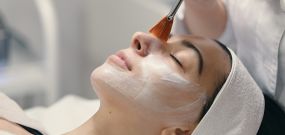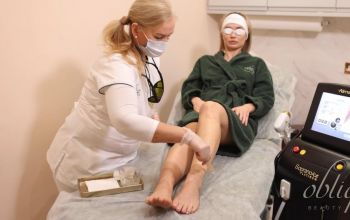Have you ever wanted perfect, baby-like skin? You may want to look into chemical peels.
Solutions are applied to the skin to remove damaged skin cells and bring out the beautiful skin you have waiting underneath.
You’ve got quite a few options depending on what your needs are and how sensitive your skin is. For the best effects, it’s important that you speak to one of our therapists, to see what would best suit your skin needs.
Skincare should not be taken lightly, so make sure you know as much as you can, especially when looking at a chemical solution.
One thing to pay attention to when researching chemical peels are the types of acids they contain.
Common acids used include:
- Glycolic Acid
- Salicylic Acid
- Lactic Acid
- Phytic Acid
- Retinoic Acid
- Trichloroacetic Acid (TCA)
- Carbolic Acid
The different types of chemical peels
Glycolic Chemical Peel
Sometimes, you need a deep chemical peel. Out of all the chemical peels available, the glycolic peel penetrates your skin the deepest, so it’s the best one for exfoliation. This is due to glycolic acid’s small molecular structure, which allows it to penetrate deep into the layer of skin. It’s also good for bringing a healthy glow back to aging skin.
Glycolic peels come in different intensities and can affect your skin differently depending on how strong it is.
Lactic Chemical Peel
If your skin is sensitive, some of the peels on this list may irritate it. You may want to look into a light chemical peel, such as a lactic peel. As the name suggests, lactic peels come from milk and utilise lactic acid. It’s not only gentle on easily irritated skin but also moisturizes dry skin.
Beta Chemical Peel
Acne can be embarrassing and annoying to deal with. If you have a bunch of problem breakouts, a beta peel will be able to help you. It contains salicylic acid which is great for exfoliation and oil control. Salicylic acid also has anti-inflammatory and antibacterial properties. Salicylic acid takes care of the bacteria that cause acne breakouts to give you the relief that you’ve been searching for.
Vitalise Chemical Peel
If you’ve never had a chemical peel before, the vitalise peel is a good place to start because there is little peeling involved with it. It uses citric acid, salicylic acid, lactic acid, and retinol to lighten your skin’s pigmentation and improve its overall quality. This type of chemical peel is a good place to start for many skin types.
TCA Chemical Peel
Trichloroacetic Acid, often referred to as TCA, is an effective chemical agent used to exfoliate and renew the skin from a superficial to deep level. TCA is commonly applied to the face, neck, décolleté, hands, and legs. In addition, Trichloroacetic acid is also an excellent “spot treatment” and can be used to exclusively peel isolated areas of the skin.
Retinol Chemical Peel
Retinol is a form of vitamin A, which is used in skincare products as it encourages the growth of skin cells once it is applied. Due to its small molecular size, retinol is able to penetrate into the deeper layers of your skin. As this is where your live cells are, the retinol that reaches this level encourages your skin cells to grow and renew. A retinol peel can also help unclog your pores and reduce acne outbreaks by allowing the cleansed skin to heal. A retinol peel is ideal if you want to rejuvenate, hydrate, and refresh your complexion.
Mandalic Chemical Peel
Mandalic acid is a go-to anti-aging ingredient in the world of skin care. It works to accelerate cell turnover by dissolving the tiny bonds that hold the cells of the skin together, helping to remove dead skin on the surface of the skin that can lead to dull complexions as well as lines. It also strengthens collagen, one of the building blocks of the skin’s support network that gives it a youthful firmness.
Mandelic acid and other alpha hydroxy acids generally soften the appearance of fine lines and wrinkles and improve skin texture.












